Challenges of Talent Management in Business: Unilever Report
VerifiedAdded on 2022/12/27
|24
|4852
|41
Report
AI Summary
This report delves into the intricacies of talent management, focusing on the case study of Unilever. The study begins by outlining the aims and objectives of the research, specifically targeting the challenges faced in retaining employees and the importance of talent management within an organization. It then constructs a performance management plan, including a Gantt chart and work breakdown structure to organize project stages. The research employs both qualitative and quantitative methods, utilizing questionnaires and secondary data from various sources. Findings are presented using appropriate tools, leading to recommendations aimed at addressing challenges such as ineffective guidance and high employee turnover. The report concludes with a reflection on the attainment of objectives and highlights key insights into effective talent management strategies within a business context. The report provides an in-depth analysis of talent management issues and provides actionable insights.
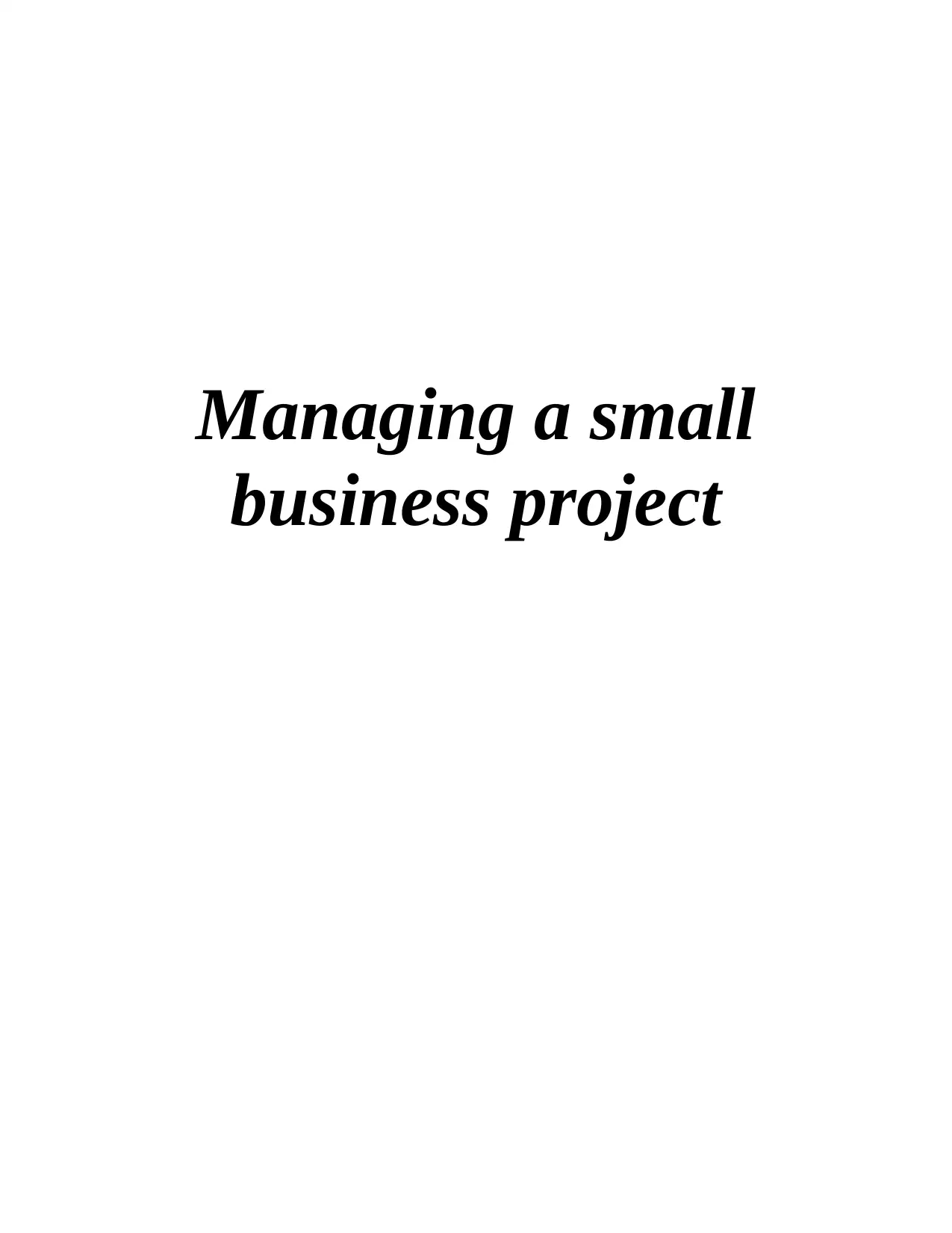
Managing a small
business project
business project
Paraphrase This Document
Need a fresh take? Get an instant paraphrase of this document with our AI Paraphraser
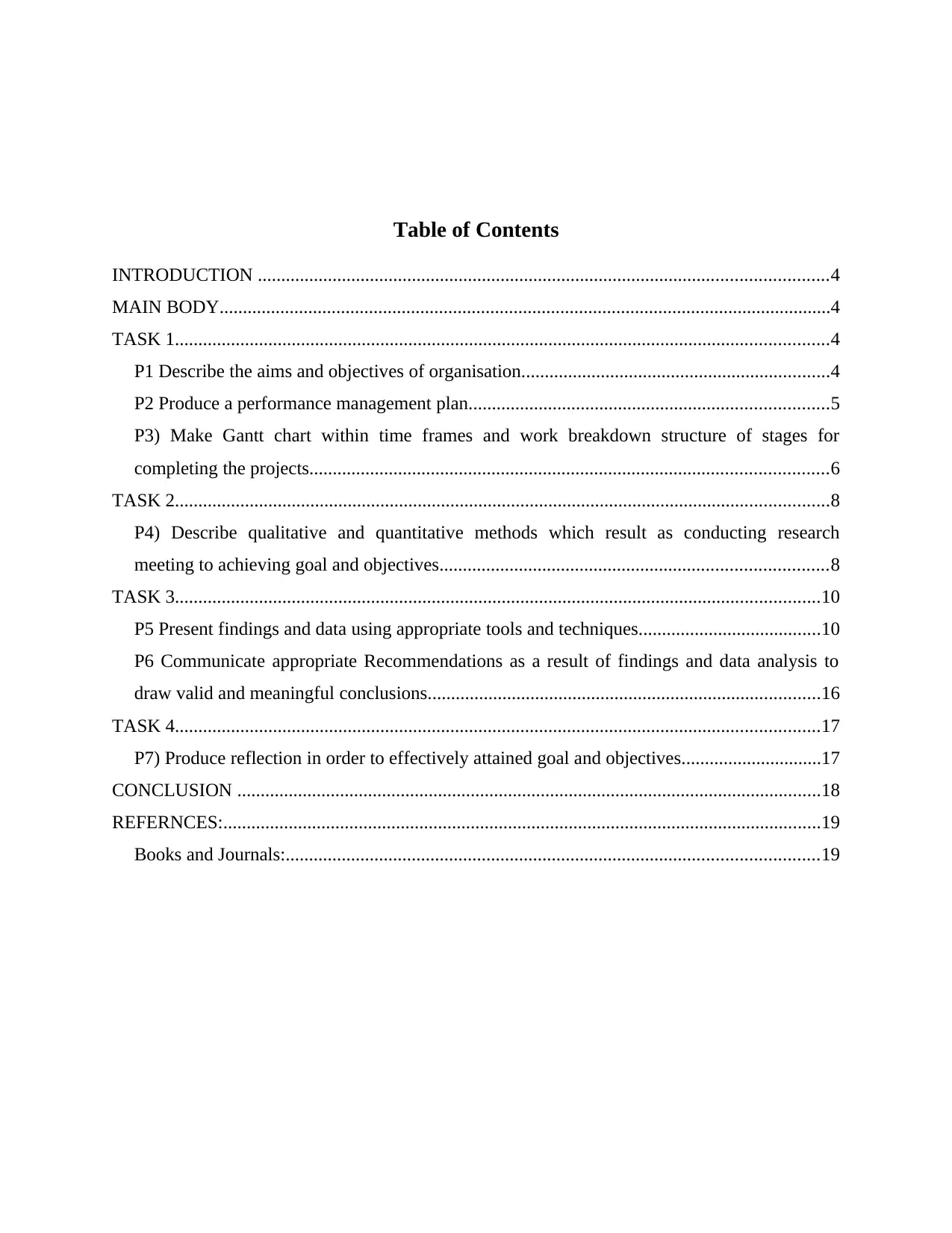
Table of Contents
INTRODUCTION ..........................................................................................................................4
MAIN BODY...................................................................................................................................4
TASK 1............................................................................................................................................4
P1 Describe the aims and objectives of organisation..................................................................4
P2 Produce a performance management plan.............................................................................5
P3) Make Gantt chart within time frames and work breakdown structure of stages for
completing the projects...............................................................................................................6
TASK 2............................................................................................................................................8
P4) Describe qualitative and quantitative methods which result as conducting research
meeting to achieving goal and objectives...................................................................................8
TASK 3..........................................................................................................................................10
P5 Present findings and data using appropriate tools and techniques.......................................10
P6 Communicate appropriate Recommendations as a result of findings and data analysis to
draw valid and meaningful conclusions....................................................................................16
TASK 4..........................................................................................................................................17
P7) Produce reflection in order to effectively attained goal and objectives..............................17
CONCLUSION .............................................................................................................................18
REFERNCES:................................................................................................................................19
Books and Journals:..................................................................................................................19
INTRODUCTION ..........................................................................................................................4
MAIN BODY...................................................................................................................................4
TASK 1............................................................................................................................................4
P1 Describe the aims and objectives of organisation..................................................................4
P2 Produce a performance management plan.............................................................................5
P3) Make Gantt chart within time frames and work breakdown structure of stages for
completing the projects...............................................................................................................6
TASK 2............................................................................................................................................8
P4) Describe qualitative and quantitative methods which result as conducting research
meeting to achieving goal and objectives...................................................................................8
TASK 3..........................................................................................................................................10
P5 Present findings and data using appropriate tools and techniques.......................................10
P6 Communicate appropriate Recommendations as a result of findings and data analysis to
draw valid and meaningful conclusions....................................................................................16
TASK 4..........................................................................................................................................17
P7) Produce reflection in order to effectively attained goal and objectives..............................17
CONCLUSION .............................................................................................................................18
REFERNCES:................................................................................................................................19
Books and Journals:..................................................................................................................19
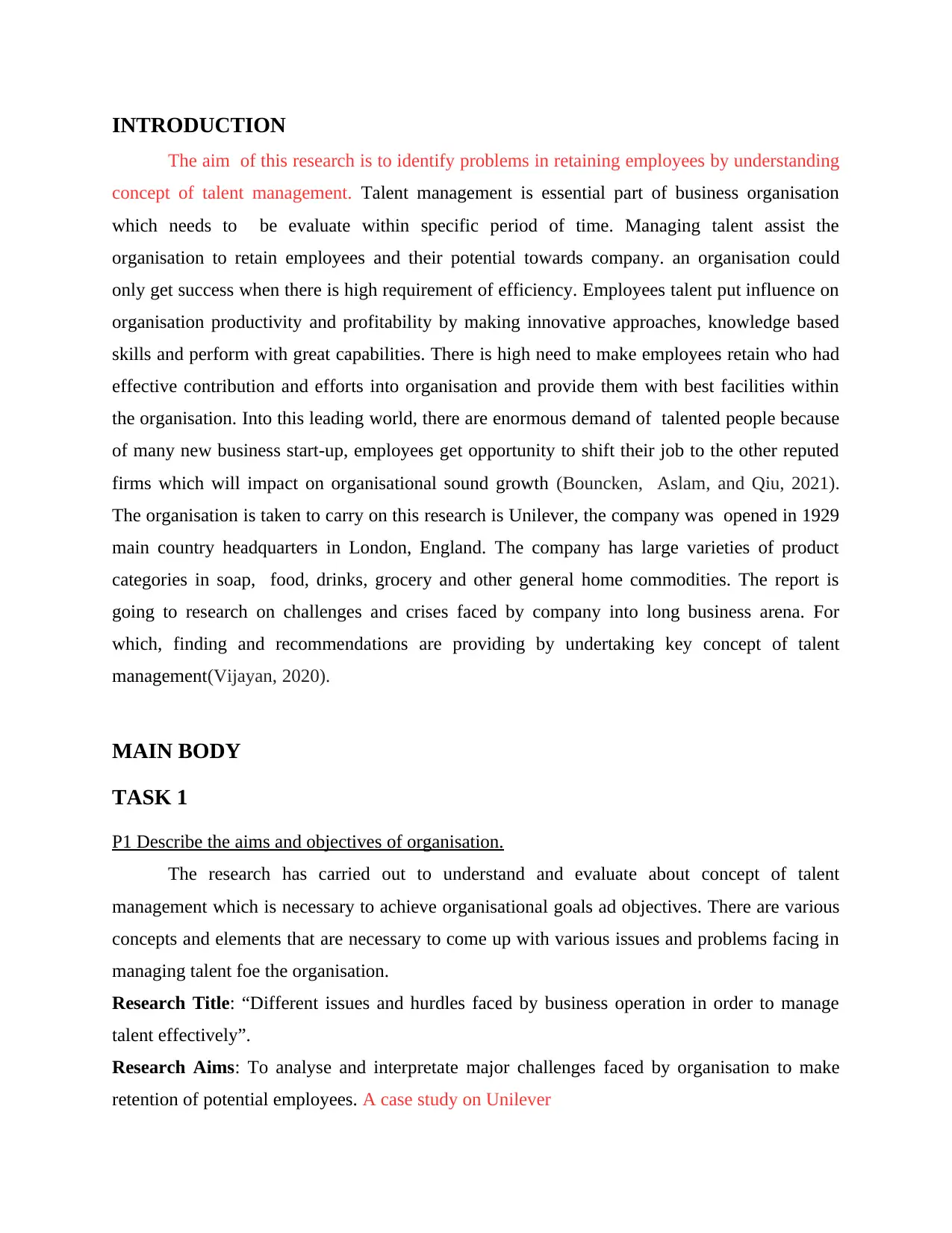
INTRODUCTION
The aim of this research is to identify problems in retaining employees by understanding
concept of talent management. Talent management is essential part of business organisation
which needs to be evaluate within specific period of time. Managing talent assist the
organisation to retain employees and their potential towards company. an organisation could
only get success when there is high requirement of efficiency. Employees talent put influence on
organisation productivity and profitability by making innovative approaches, knowledge based
skills and perform with great capabilities. There is high need to make employees retain who had
effective contribution and efforts into organisation and provide them with best facilities within
the organisation. Into this leading world, there are enormous demand of talented people because
of many new business start-up, employees get opportunity to shift their job to the other reputed
firms which will impact on organisational sound growth (Bouncken, Aslam, and Qiu, 2021).
The organisation is taken to carry on this research is Unilever, the company was opened in 1929
main country headquarters in London, England. The company has large varieties of product
categories in soap, food, drinks, grocery and other general home commodities. The report is
going to research on challenges and crises faced by company into long business arena. For
which, finding and recommendations are providing by undertaking key concept of talent
management(Vijayan, 2020).
MAIN BODY
TASK 1
P1 Describe the aims and objectives of organisation.
The research has carried out to understand and evaluate about concept of talent
management which is necessary to achieve organisational goals ad objectives. There are various
concepts and elements that are necessary to come up with various issues and problems facing in
managing talent foe the organisation.
Research Title: “Different issues and hurdles faced by business operation in order to manage
talent effectively”.
Research Aims: To analyse and interpretate major challenges faced by organisation to make
retention of potential employees. A case study on Unilever
The aim of this research is to identify problems in retaining employees by understanding
concept of talent management. Talent management is essential part of business organisation
which needs to be evaluate within specific period of time. Managing talent assist the
organisation to retain employees and their potential towards company. an organisation could
only get success when there is high requirement of efficiency. Employees talent put influence on
organisation productivity and profitability by making innovative approaches, knowledge based
skills and perform with great capabilities. There is high need to make employees retain who had
effective contribution and efforts into organisation and provide them with best facilities within
the organisation. Into this leading world, there are enormous demand of talented people because
of many new business start-up, employees get opportunity to shift their job to the other reputed
firms which will impact on organisational sound growth (Bouncken, Aslam, and Qiu, 2021).
The organisation is taken to carry on this research is Unilever, the company was opened in 1929
main country headquarters in London, England. The company has large varieties of product
categories in soap, food, drinks, grocery and other general home commodities. The report is
going to research on challenges and crises faced by company into long business arena. For
which, finding and recommendations are providing by undertaking key concept of talent
management(Vijayan, 2020).
MAIN BODY
TASK 1
P1 Describe the aims and objectives of organisation.
The research has carried out to understand and evaluate about concept of talent
management which is necessary to achieve organisational goals ad objectives. There are various
concepts and elements that are necessary to come up with various issues and problems facing in
managing talent foe the organisation.
Research Title: “Different issues and hurdles faced by business operation in order to manage
talent effectively”.
Research Aims: To analyse and interpretate major challenges faced by organisation to make
retention of potential employees. A case study on Unilever
⊘ This is a preview!⊘
Do you want full access?
Subscribe today to unlock all pages.

Trusted by 1+ million students worldwide
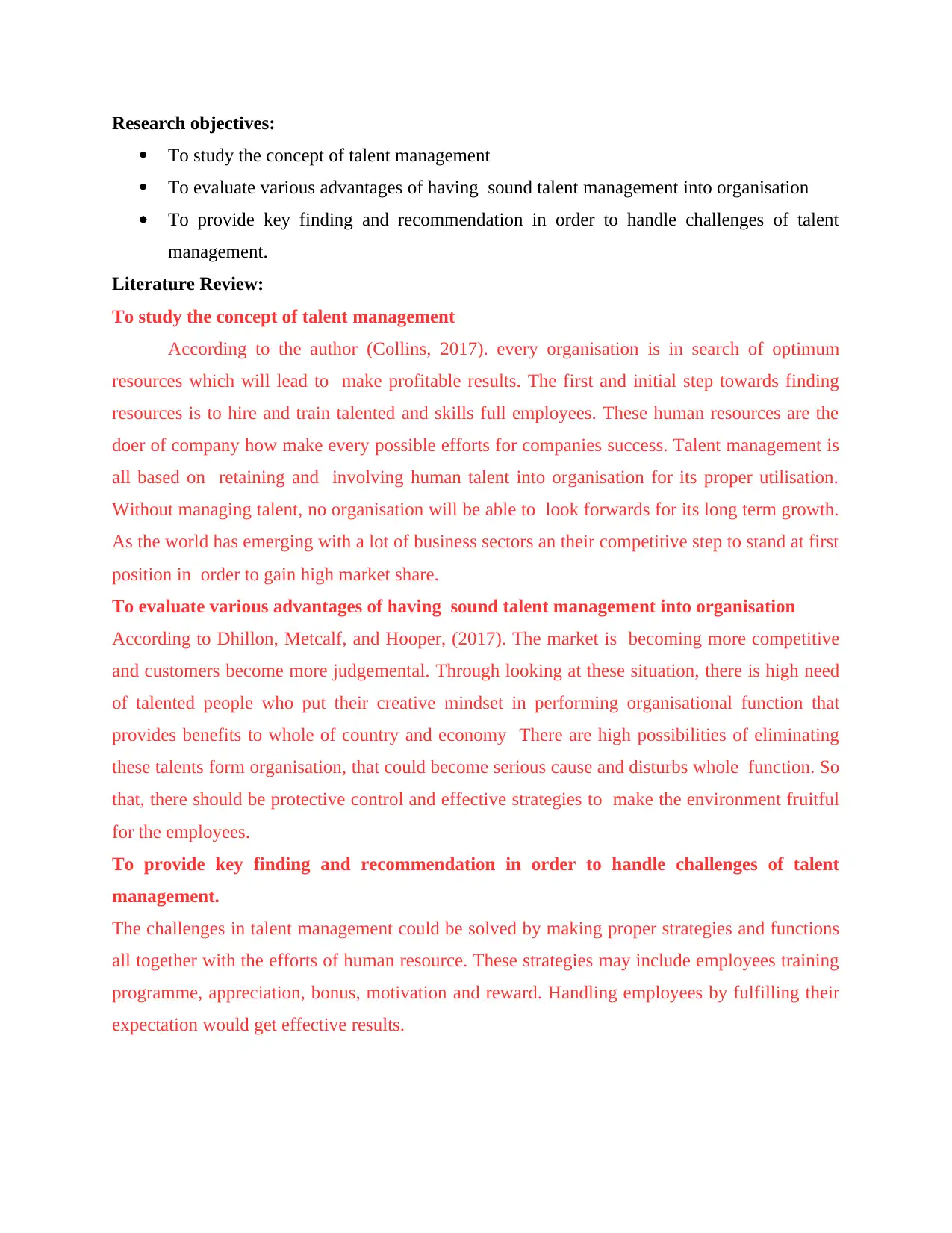
Research objectives:
To study the concept of talent management
To evaluate various advantages of having sound talent management into organisation
To provide key finding and recommendation in order to handle challenges of talent
management.
Literature Review:
To study the concept of talent management
According to the author (Collins, 2017). every organisation is in search of optimum
resources which will lead to make profitable results. The first and initial step towards finding
resources is to hire and train talented and skills full employees. These human resources are the
doer of company how make every possible efforts for companies success. Talent management is
all based on retaining and involving human talent into organisation for its proper utilisation.
Without managing talent, no organisation will be able to look forwards for its long term growth.
As the world has emerging with a lot of business sectors an their competitive step to stand at first
position in order to gain high market share.
To evaluate various advantages of having sound talent management into organisation
According to Dhillon, Metcalf, and Hooper, (2017). The market is becoming more competitive
and customers become more judgemental. Through looking at these situation, there is high need
of talented people who put their creative mindset in performing organisational function that
provides benefits to whole of country and economy There are high possibilities of eliminating
these talents form organisation, that could become serious cause and disturbs whole function. So
that, there should be protective control and effective strategies to make the environment fruitful
for the employees.
To provide key finding and recommendation in order to handle challenges of talent
management.
The challenges in talent management could be solved by making proper strategies and functions
all together with the efforts of human resource. These strategies may include employees training
programme, appreciation, bonus, motivation and reward. Handling employees by fulfilling their
expectation would get effective results.
To study the concept of talent management
To evaluate various advantages of having sound talent management into organisation
To provide key finding and recommendation in order to handle challenges of talent
management.
Literature Review:
To study the concept of talent management
According to the author (Collins, 2017). every organisation is in search of optimum
resources which will lead to make profitable results. The first and initial step towards finding
resources is to hire and train talented and skills full employees. These human resources are the
doer of company how make every possible efforts for companies success. Talent management is
all based on retaining and involving human talent into organisation for its proper utilisation.
Without managing talent, no organisation will be able to look forwards for its long term growth.
As the world has emerging with a lot of business sectors an their competitive step to stand at first
position in order to gain high market share.
To evaluate various advantages of having sound talent management into organisation
According to Dhillon, Metcalf, and Hooper, (2017). The market is becoming more competitive
and customers become more judgemental. Through looking at these situation, there is high need
of talented people who put their creative mindset in performing organisational function that
provides benefits to whole of country and economy There are high possibilities of eliminating
these talents form organisation, that could become serious cause and disturbs whole function. So
that, there should be protective control and effective strategies to make the environment fruitful
for the employees.
To provide key finding and recommendation in order to handle challenges of talent
management.
The challenges in talent management could be solved by making proper strategies and functions
all together with the efforts of human resource. These strategies may include employees training
programme, appreciation, bonus, motivation and reward. Handling employees by fulfilling their
expectation would get effective results.
Paraphrase This Document
Need a fresh take? Get an instant paraphrase of this document with our AI Paraphraser
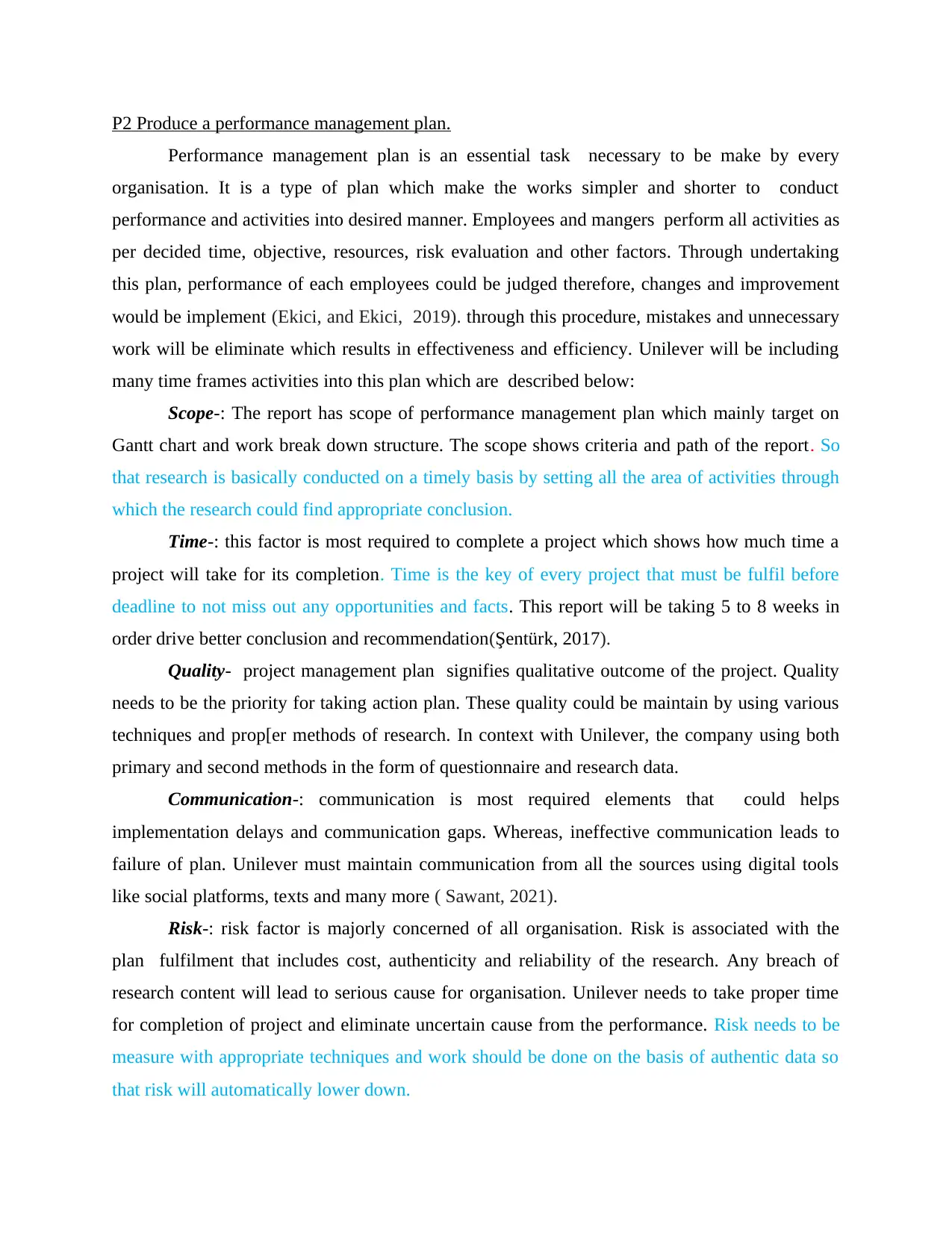
P2 Produce a performance management plan.
Performance management plan is an essential task necessary to be make by every
organisation. It is a type of plan which make the works simpler and shorter to conduct
performance and activities into desired manner. Employees and mangers perform all activities as
per decided time, objective, resources, risk evaluation and other factors. Through undertaking
this plan, performance of each employees could be judged therefore, changes and improvement
would be implement (Ekici, and Ekici, 2019). through this procedure, mistakes and unnecessary
work will be eliminate which results in effectiveness and efficiency. Unilever will be including
many time frames activities into this plan which are described below:
Scope-: The report has scope of performance management plan which mainly target on
Gantt chart and work break down structure. The scope shows criteria and path of the report. So
that research is basically conducted on a timely basis by setting all the area of activities through
which the research could find appropriate conclusion.
Time-: this factor is most required to complete a project which shows how much time a
project will take for its completion. Time is the key of every project that must be fulfil before
deadline to not miss out any opportunities and facts. This report will be taking 5 to 8 weeks in
order drive better conclusion and recommendation(Şentürk, 2017).
Quality- project management plan signifies qualitative outcome of the project. Quality
needs to be the priority for taking action plan. These quality could be maintain by using various
techniques and prop[er methods of research. In context with Unilever, the company using both
primary and second methods in the form of questionnaire and research data.
Communication-: communication is most required elements that could helps
implementation delays and communication gaps. Whereas, ineffective communication leads to
failure of plan. Unilever must maintain communication from all the sources using digital tools
like social platforms, texts and many more ( Sawant, 2021).
Risk-: risk factor is majorly concerned of all organisation. Risk is associated with the
plan fulfilment that includes cost, authenticity and reliability of the research. Any breach of
research content will lead to serious cause for organisation. Unilever needs to take proper time
for completion of project and eliminate uncertain cause from the performance. Risk needs to be
measure with appropriate techniques and work should be done on the basis of authentic data so
that risk will automatically lower down.
Performance management plan is an essential task necessary to be make by every
organisation. It is a type of plan which make the works simpler and shorter to conduct
performance and activities into desired manner. Employees and mangers perform all activities as
per decided time, objective, resources, risk evaluation and other factors. Through undertaking
this plan, performance of each employees could be judged therefore, changes and improvement
would be implement (Ekici, and Ekici, 2019). through this procedure, mistakes and unnecessary
work will be eliminate which results in effectiveness and efficiency. Unilever will be including
many time frames activities into this plan which are described below:
Scope-: The report has scope of performance management plan which mainly target on
Gantt chart and work break down structure. The scope shows criteria and path of the report. So
that research is basically conducted on a timely basis by setting all the area of activities through
which the research could find appropriate conclusion.
Time-: this factor is most required to complete a project which shows how much time a
project will take for its completion. Time is the key of every project that must be fulfil before
deadline to not miss out any opportunities and facts. This report will be taking 5 to 8 weeks in
order drive better conclusion and recommendation(Şentürk, 2017).
Quality- project management plan signifies qualitative outcome of the project. Quality
needs to be the priority for taking action plan. These quality could be maintain by using various
techniques and prop[er methods of research. In context with Unilever, the company using both
primary and second methods in the form of questionnaire and research data.
Communication-: communication is most required elements that could helps
implementation delays and communication gaps. Whereas, ineffective communication leads to
failure of plan. Unilever must maintain communication from all the sources using digital tools
like social platforms, texts and many more ( Sawant, 2021).
Risk-: risk factor is majorly concerned of all organisation. Risk is associated with the
plan fulfilment that includes cost, authenticity and reliability of the research. Any breach of
research content will lead to serious cause for organisation. Unilever needs to take proper time
for completion of project and eliminate uncertain cause from the performance. Risk needs to be
measure with appropriate techniques and work should be done on the basis of authentic data so
that risk will automatically lower down.
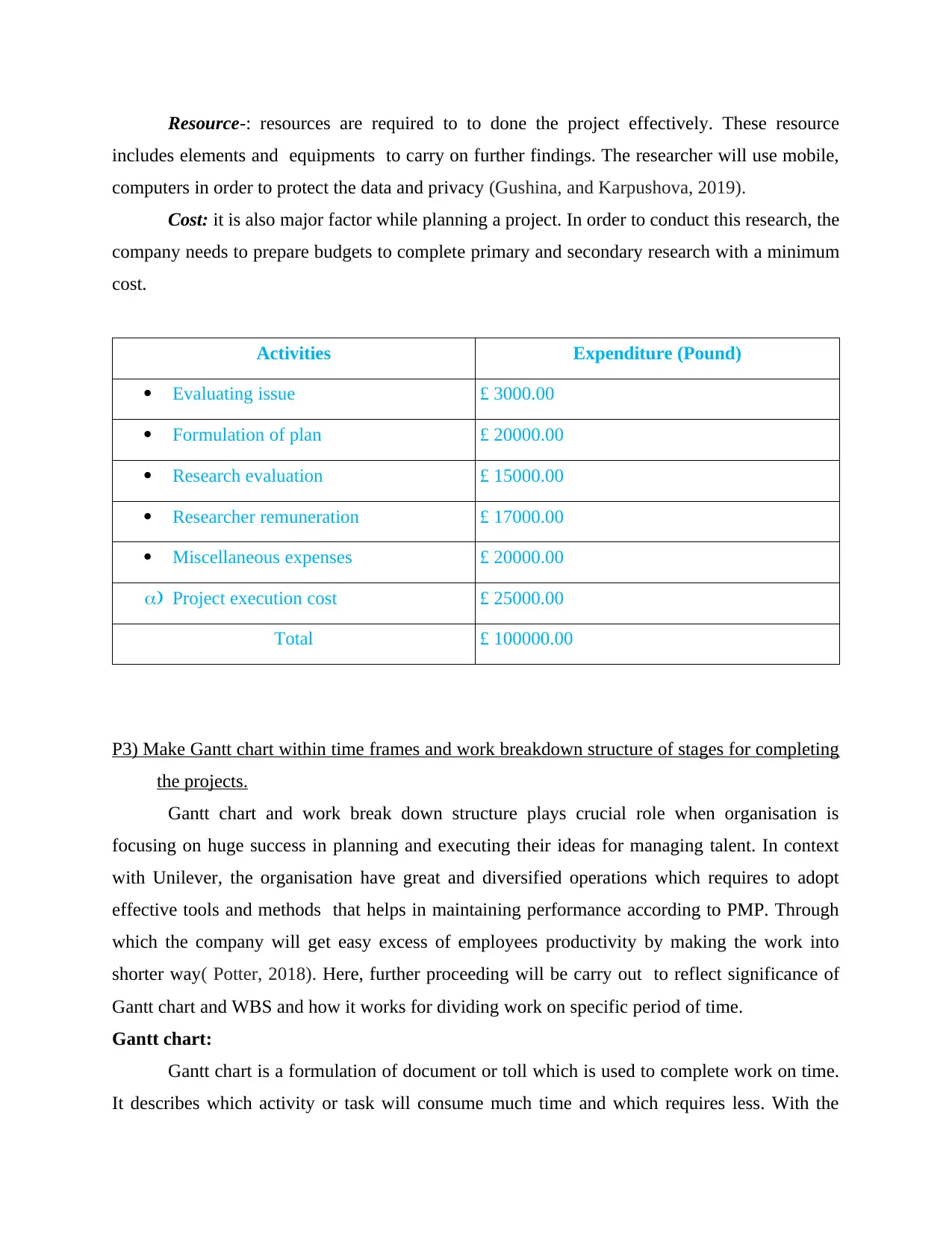
Resource-: resources are required to to done the project effectively. These resource
includes elements and equipments to carry on further findings. The researcher will use mobile,
computers in order to protect the data and privacy (Gushina, and Karpushova, 2019).
Cost: it is also major factor while planning a project. In order to conduct this research, the
company needs to prepare budgets to complete primary and secondary research with a minimum
cost.
Activities Expenditure (Pound)
Evaluating issue £ 3000.00
Formulation of plan £ 20000.00
Research evaluation £ 15000.00
Researcher remuneration £ 17000.00
Miscellaneous expenses £ 20000.00
a) Project execution cost £ 25000.00
Total £ 100000.00
P3) Make Gantt chart within time frames and work breakdown structure of stages for completing
the projects.
Gantt chart and work break down structure plays crucial role when organisation is
focusing on huge success in planning and executing their ideas for managing talent. In context
with Unilever, the organisation have great and diversified operations which requires to adopt
effective tools and methods that helps in maintaining performance according to PMP. Through
which the company will get easy excess of employees productivity by making the work into
shorter way( Potter, 2018). Here, further proceeding will be carry out to reflect significance of
Gantt chart and WBS and how it works for dividing work on specific period of time.
Gantt chart:
Gantt chart is a formulation of document or toll which is used to complete work on time.
It describes which activity or task will consume much time and which requires less. With the
includes elements and equipments to carry on further findings. The researcher will use mobile,
computers in order to protect the data and privacy (Gushina, and Karpushova, 2019).
Cost: it is also major factor while planning a project. In order to conduct this research, the
company needs to prepare budgets to complete primary and secondary research with a minimum
cost.
Activities Expenditure (Pound)
Evaluating issue £ 3000.00
Formulation of plan £ 20000.00
Research evaluation £ 15000.00
Researcher remuneration £ 17000.00
Miscellaneous expenses £ 20000.00
a) Project execution cost £ 25000.00
Total £ 100000.00
P3) Make Gantt chart within time frames and work breakdown structure of stages for completing
the projects.
Gantt chart and work break down structure plays crucial role when organisation is
focusing on huge success in planning and executing their ideas for managing talent. In context
with Unilever, the organisation have great and diversified operations which requires to adopt
effective tools and methods that helps in maintaining performance according to PMP. Through
which the company will get easy excess of employees productivity by making the work into
shorter way( Potter, 2018). Here, further proceeding will be carry out to reflect significance of
Gantt chart and WBS and how it works for dividing work on specific period of time.
Gantt chart:
Gantt chart is a formulation of document or toll which is used to complete work on time.
It describes which activity or task will consume much time and which requires less. With the
⊘ This is a preview!⊘
Do you want full access?
Subscribe today to unlock all pages.

Trusted by 1+ million students worldwide
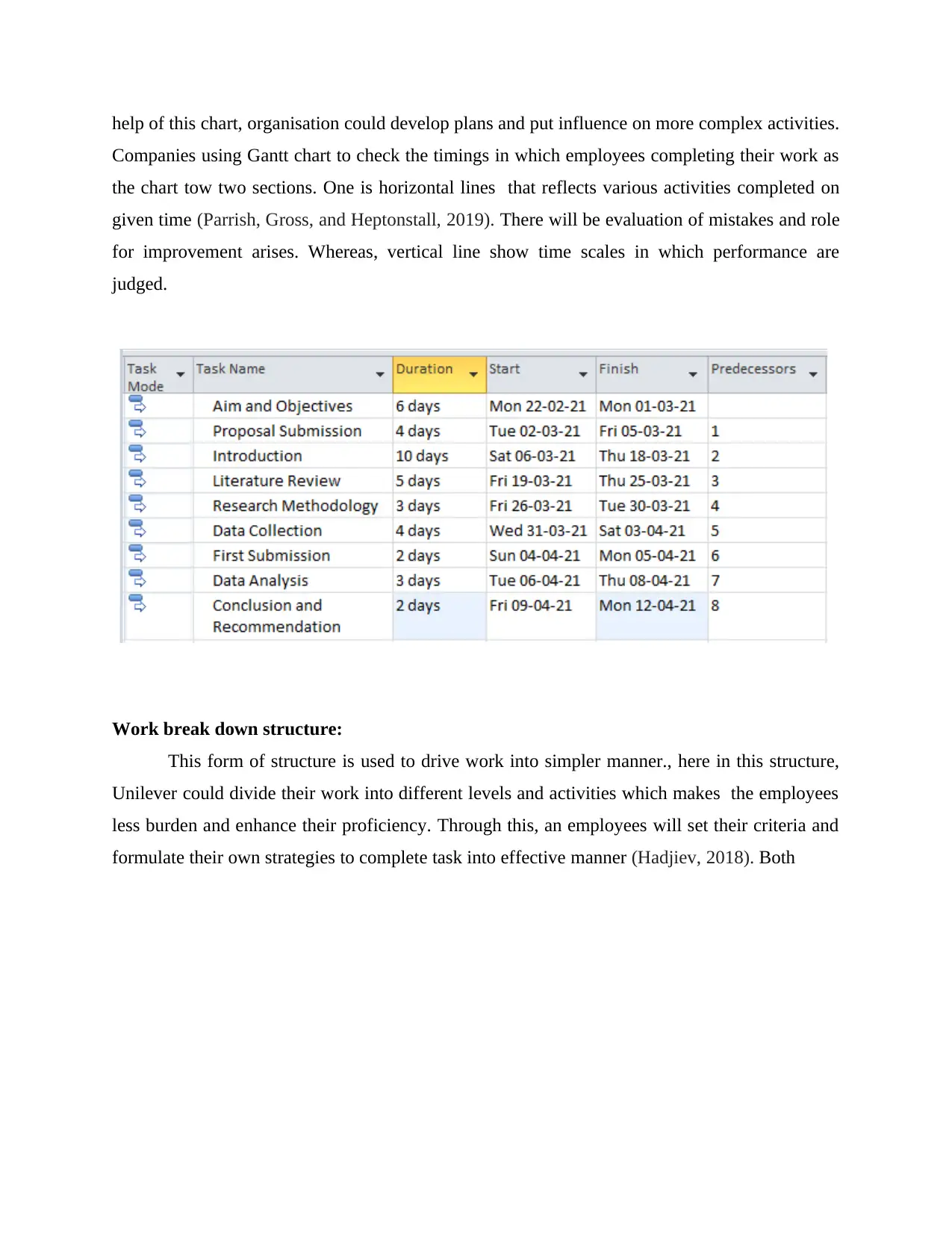
help of this chart, organisation could develop plans and put influence on more complex activities.
Companies using Gantt chart to check the timings in which employees completing their work as
the chart tow two sections. One is horizontal lines that reflects various activities completed on
given time (Parrish, Gross, and Heptonstall, 2019). There will be evaluation of mistakes and role
for improvement arises. Whereas, vertical line show time scales in which performance are
judged.
Work break down structure:
This form of structure is used to drive work into simpler manner., here in this structure,
Unilever could divide their work into different levels and activities which makes the employees
less burden and enhance their proficiency. Through this, an employees will set their criteria and
formulate their own strategies to complete task into effective manner (Hadjiev, 2018). Both
Companies using Gantt chart to check the timings in which employees completing their work as
the chart tow two sections. One is horizontal lines that reflects various activities completed on
given time (Parrish, Gross, and Heptonstall, 2019). There will be evaluation of mistakes and role
for improvement arises. Whereas, vertical line show time scales in which performance are
judged.
Work break down structure:
This form of structure is used to drive work into simpler manner., here in this structure,
Unilever could divide their work into different levels and activities which makes the employees
less burden and enhance their proficiency. Through this, an employees will set their criteria and
formulate their own strategies to complete task into effective manner (Hadjiev, 2018). Both
Paraphrase This Document
Need a fresh take? Get an instant paraphrase of this document with our AI Paraphraser
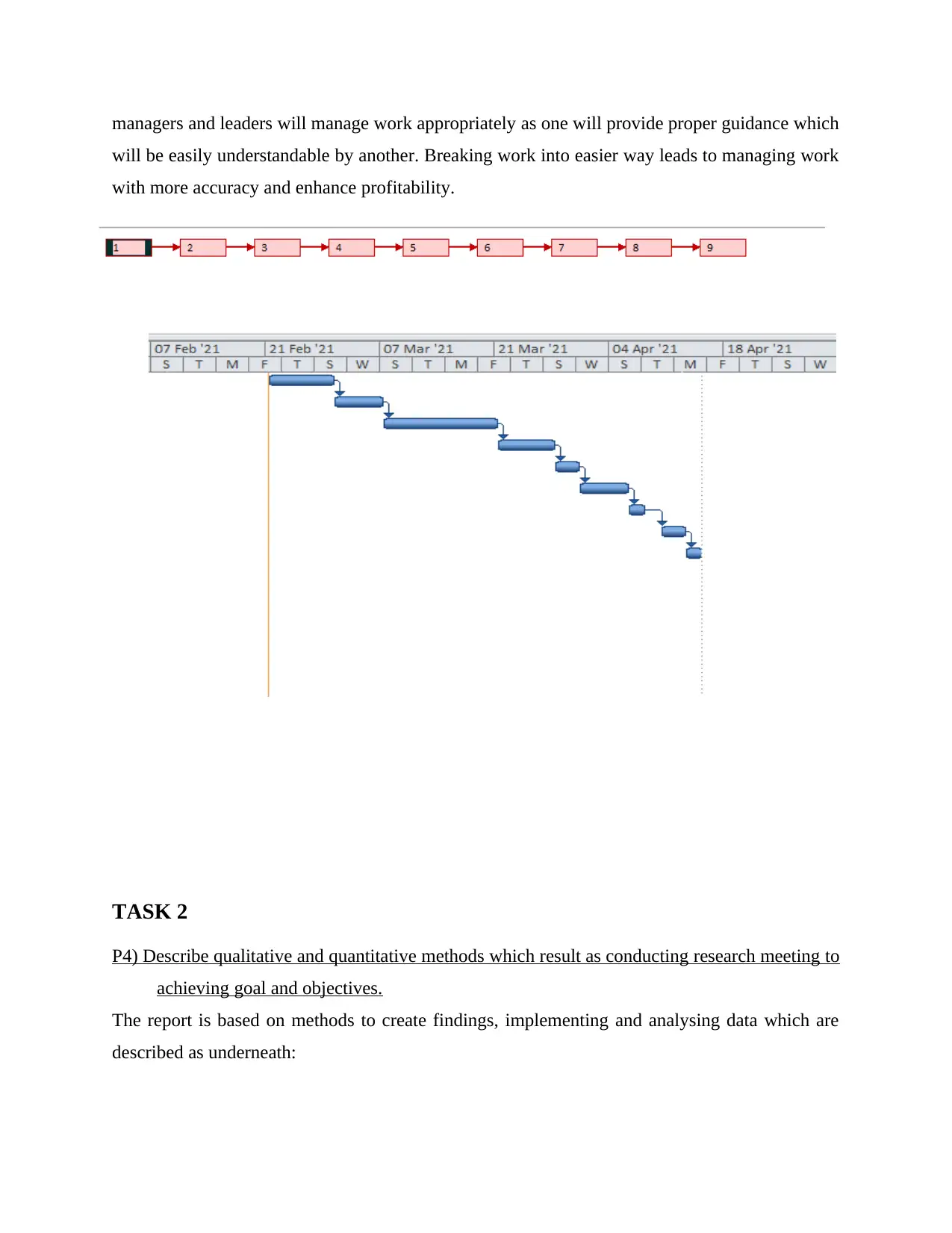
managers and leaders will manage work appropriately as one will provide proper guidance which
will be easily understandable by another. Breaking work into easier way leads to managing work
with more accuracy and enhance profitability.
TASK 2
P4) Describe qualitative and quantitative methods which result as conducting research meeting to
achieving goal and objectives.
The report is based on methods to create findings, implementing and analysing data which are
described as underneath:
will be easily understandable by another. Breaking work into easier way leads to managing work
with more accuracy and enhance profitability.
TASK 2
P4) Describe qualitative and quantitative methods which result as conducting research meeting to
achieving goal and objectives.
The report is based on methods to create findings, implementing and analysing data which are
described as underneath:
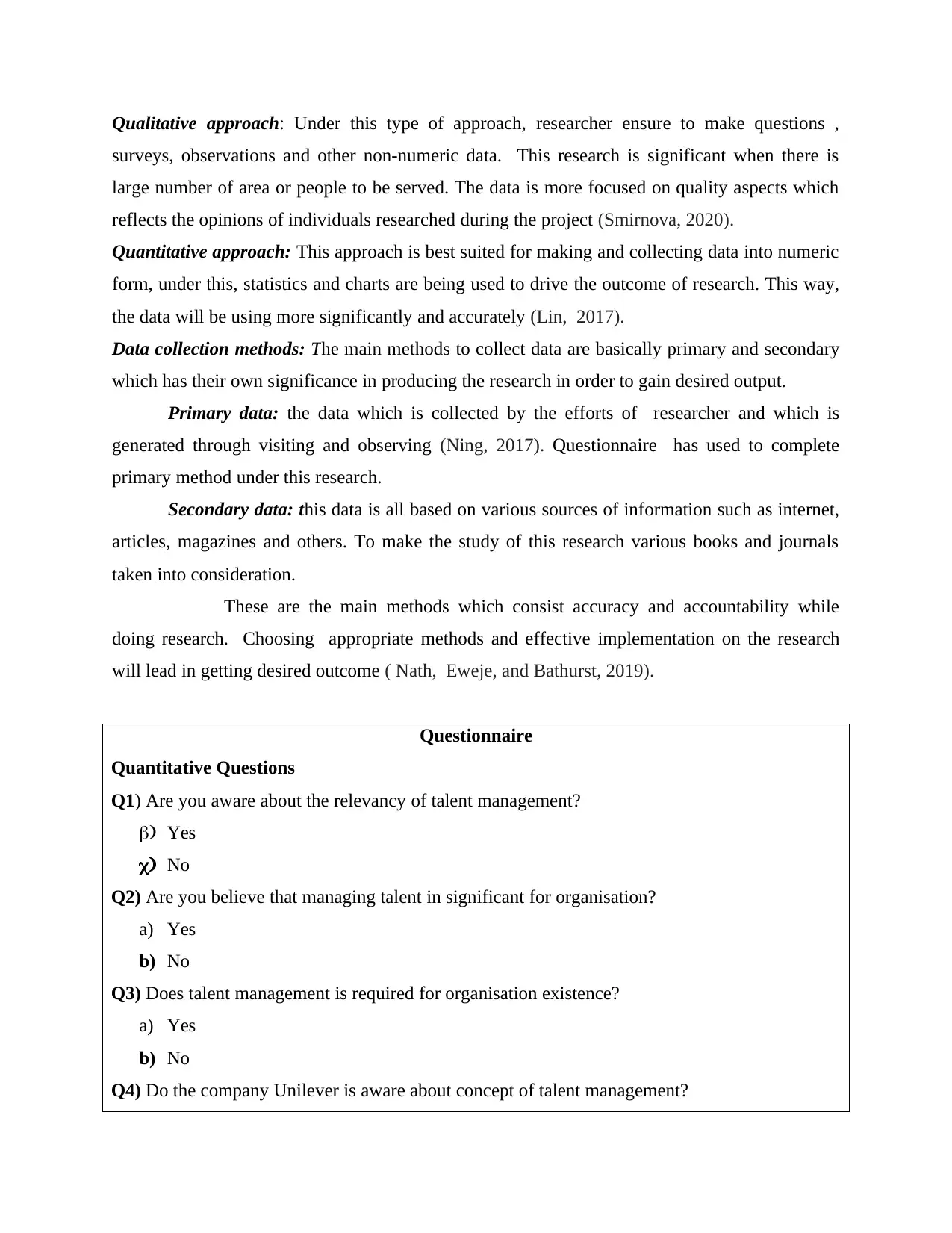
Qualitative approach: Under this type of approach, researcher ensure to make questions ,
surveys, observations and other non-numeric data. This research is significant when there is
large number of area or people to be served. The data is more focused on quality aspects which
reflects the opinions of individuals researched during the project (Smirnova, 2020).
Quantitative approach: This approach is best suited for making and collecting data into numeric
form, under this, statistics and charts are being used to drive the outcome of research. This way,
the data will be using more significantly and accurately (Lin, 2017).
Data collection methods: The main methods to collect data are basically primary and secondary
which has their own significance in producing the research in order to gain desired output.
Primary data: the data which is collected by the efforts of researcher and which is
generated through visiting and observing (Ning, 2017). Questionnaire has used to complete
primary method under this research.
Secondary data: this data is all based on various sources of information such as internet,
articles, magazines and others. To make the study of this research various books and journals
taken into consideration.
These are the main methods which consist accuracy and accountability while
doing research. Choosing appropriate methods and effective implementation on the research
will lead in getting desired outcome ( Nath, Eweje, and Bathurst, 2019).
Questionnaire
Quantitative Questions
Q1) Are you aware about the relevancy of talent management?
b) Yes
c) No
Q2) Are you believe that managing talent in significant for organisation?
a) Yes
b) No
Q3) Does talent management is required for organisation existence?
a) Yes
b) No
Q4) Do the company Unilever is aware about concept of talent management?
surveys, observations and other non-numeric data. This research is significant when there is
large number of area or people to be served. The data is more focused on quality aspects which
reflects the opinions of individuals researched during the project (Smirnova, 2020).
Quantitative approach: This approach is best suited for making and collecting data into numeric
form, under this, statistics and charts are being used to drive the outcome of research. This way,
the data will be using more significantly and accurately (Lin, 2017).
Data collection methods: The main methods to collect data are basically primary and secondary
which has their own significance in producing the research in order to gain desired output.
Primary data: the data which is collected by the efforts of researcher and which is
generated through visiting and observing (Ning, 2017). Questionnaire has used to complete
primary method under this research.
Secondary data: this data is all based on various sources of information such as internet,
articles, magazines and others. To make the study of this research various books and journals
taken into consideration.
These are the main methods which consist accuracy and accountability while
doing research. Choosing appropriate methods and effective implementation on the research
will lead in getting desired outcome ( Nath, Eweje, and Bathurst, 2019).
Questionnaire
Quantitative Questions
Q1) Are you aware about the relevancy of talent management?
b) Yes
c) No
Q2) Are you believe that managing talent in significant for organisation?
a) Yes
b) No
Q3) Does talent management is required for organisation existence?
a) Yes
b) No
Q4) Do the company Unilever is aware about concept of talent management?
⊘ This is a preview!⊘
Do you want full access?
Subscribe today to unlock all pages.

Trusted by 1+ million students worldwide
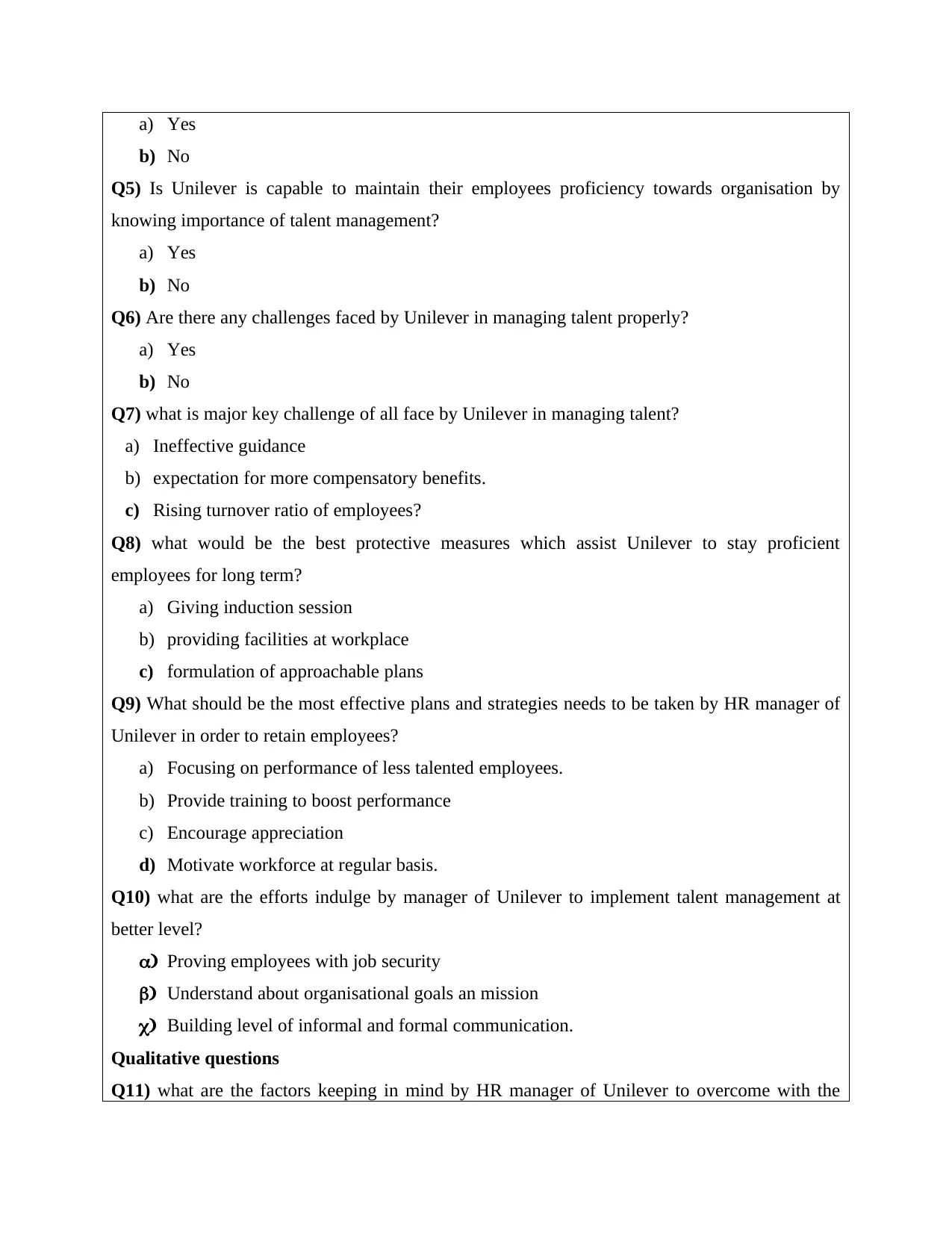
a) Yes
b) No
Q5) Is Unilever is capable to maintain their employees proficiency towards organisation by
knowing importance of talent management?
a) Yes
b) No
Q6) Are there any challenges faced by Unilever in managing talent properly?
a) Yes
b) No
Q7) what is major key challenge of all face by Unilever in managing talent?
a) Ineffective guidance
b) expectation for more compensatory benefits.
c) Rising turnover ratio of employees?
Q8) what would be the best protective measures which assist Unilever to stay proficient
employees for long term?
a) Giving induction session
b) providing facilities at workplace
c) formulation of approachable plans
Q9) What should be the most effective plans and strategies needs to be taken by HR manager of
Unilever in order to retain employees?
a) Focusing on performance of less talented employees.
b) Provide training to boost performance
c) Encourage appreciation
d) Motivate workforce at regular basis.
Q10) what are the efforts indulge by manager of Unilever to implement talent management at
better level?
a) Proving employees with job security
b) Understand about organisational goals an mission
c) Building level of informal and formal communication.
Qualitative questions
Q11) what are the factors keeping in mind by HR manager of Unilever to overcome with the
b) No
Q5) Is Unilever is capable to maintain their employees proficiency towards organisation by
knowing importance of talent management?
a) Yes
b) No
Q6) Are there any challenges faced by Unilever in managing talent properly?
a) Yes
b) No
Q7) what is major key challenge of all face by Unilever in managing talent?
a) Ineffective guidance
b) expectation for more compensatory benefits.
c) Rising turnover ratio of employees?
Q8) what would be the best protective measures which assist Unilever to stay proficient
employees for long term?
a) Giving induction session
b) providing facilities at workplace
c) formulation of approachable plans
Q9) What should be the most effective plans and strategies needs to be taken by HR manager of
Unilever in order to retain employees?
a) Focusing on performance of less talented employees.
b) Provide training to boost performance
c) Encourage appreciation
d) Motivate workforce at regular basis.
Q10) what are the efforts indulge by manager of Unilever to implement talent management at
better level?
a) Proving employees with job security
b) Understand about organisational goals an mission
c) Building level of informal and formal communication.
Qualitative questions
Q11) what are the factors keeping in mind by HR manager of Unilever to overcome with the
Paraphrase This Document
Need a fresh take? Get an instant paraphrase of this document with our AI Paraphraser
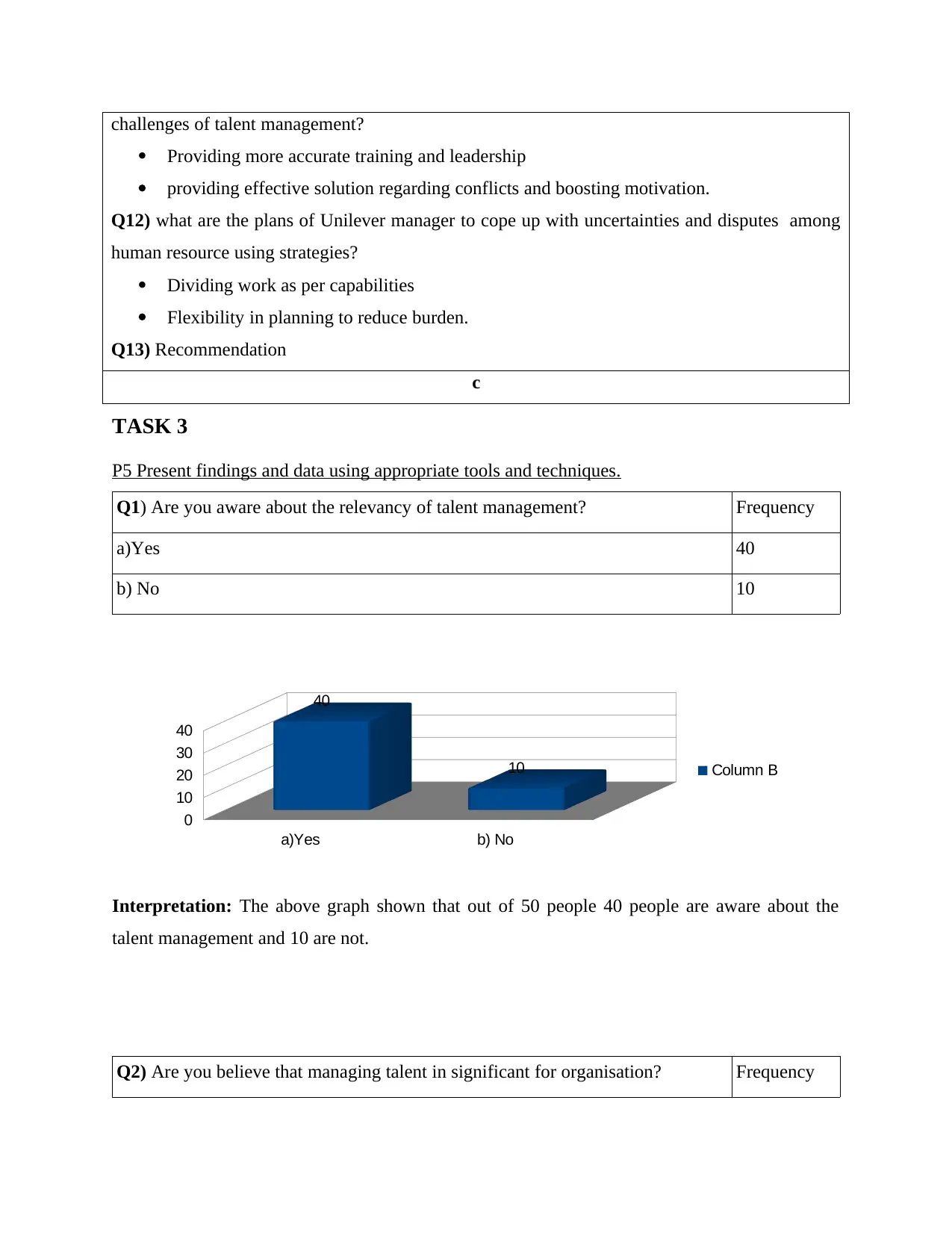
challenges of talent management?
Providing more accurate training and leadership
providing effective solution regarding conflicts and boosting motivation.
Q12) what are the plans of Unilever manager to cope up with uncertainties and disputes among
human resource using strategies?
Dividing work as per capabilities
Flexibility in planning to reduce burden.
Q13) Recommendation
c
TASK 3
P5 Present findings and data using appropriate tools and techniques.
Q1) Are you aware about the relevancy of talent management? Frequency
a)Yes 40
b) No 10
Interpretation: The above graph shown that out of 50 people 40 people are aware about the
talent management and 10 are not.
Q2) Are you believe that managing talent in significant for organisation? Frequency
a)Yes b) No
0
10
20
30
40
40
10 Column B
Providing more accurate training and leadership
providing effective solution regarding conflicts and boosting motivation.
Q12) what are the plans of Unilever manager to cope up with uncertainties and disputes among
human resource using strategies?
Dividing work as per capabilities
Flexibility in planning to reduce burden.
Q13) Recommendation
c
TASK 3
P5 Present findings and data using appropriate tools and techniques.
Q1) Are you aware about the relevancy of talent management? Frequency
a)Yes 40
b) No 10
Interpretation: The above graph shown that out of 50 people 40 people are aware about the
talent management and 10 are not.
Q2) Are you believe that managing talent in significant for organisation? Frequency
a)Yes b) No
0
10
20
30
40
40
10 Column B
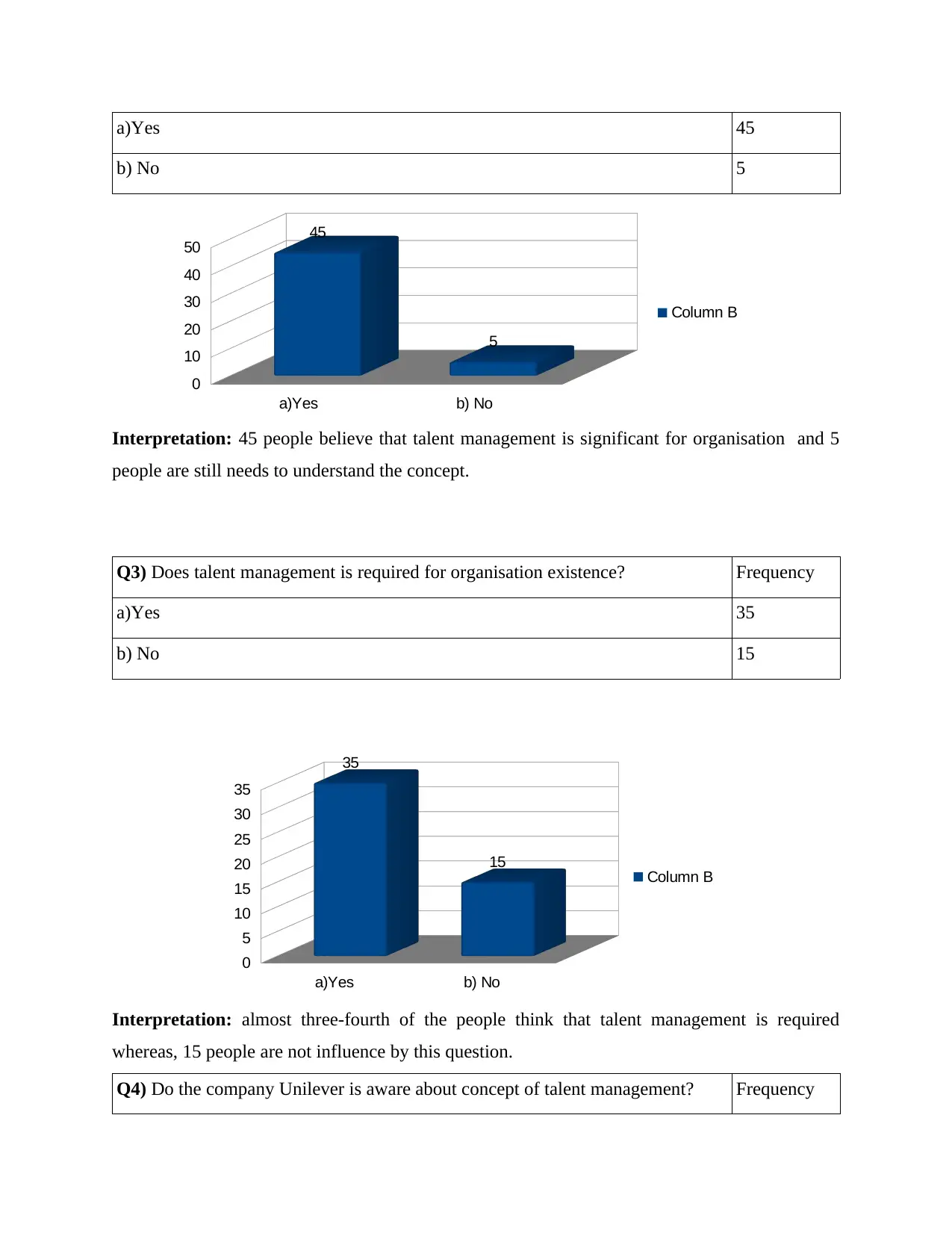
a)Yes 45
b) No 5
Interpretation: 45 people believe that talent management is significant for organisation and 5
people are still needs to understand the concept.
Q3) Does talent management is required for organisation existence? Frequency
a)Yes 35
b) No 15
Interpretation: almost three-fourth of the people think that talent management is required
whereas, 15 people are not influence by this question.
Q4) Do the company Unilever is aware about concept of talent management? Frequency
a)Yes b) No
0
10
20
30
40
50 45
5
Column B
a)Yes b) No
0
5
10
15
20
25
30
35
35
15 Column B
b) No 5
Interpretation: 45 people believe that talent management is significant for organisation and 5
people are still needs to understand the concept.
Q3) Does talent management is required for organisation existence? Frequency
a)Yes 35
b) No 15
Interpretation: almost three-fourth of the people think that talent management is required
whereas, 15 people are not influence by this question.
Q4) Do the company Unilever is aware about concept of talent management? Frequency
a)Yes b) No
0
10
20
30
40
50 45
5
Column B
a)Yes b) No
0
5
10
15
20
25
30
35
35
15 Column B
⊘ This is a preview!⊘
Do you want full access?
Subscribe today to unlock all pages.

Trusted by 1+ million students worldwide
1 out of 24
Related Documents
Your All-in-One AI-Powered Toolkit for Academic Success.
+13062052269
info@desklib.com
Available 24*7 on WhatsApp / Email
![[object Object]](/_next/static/media/star-bottom.7253800d.svg)
Unlock your academic potential
Copyright © 2020–2025 A2Z Services. All Rights Reserved. Developed and managed by ZUCOL.





